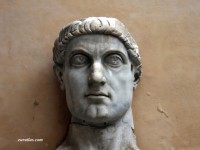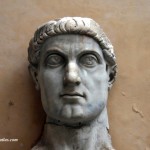The early church had few buildings. When they did construct them, they were often patterned after the Jewish Synagogues, since Christianity was originally an offshoot of Judaism. But due to intense persecution from Jewish leaders and the influx of Gentile believers, the early Christians generally owned few church buildings or places for gathering.
Over the next couple hundred years, the Roman Empire began persecuting Christians as well. Christians were viewed as bad citizens of Rome because they did not swear loyalty to the Emperor or participate in pagan temple rituals. In a culture where there is no distinction between religion and politics, those who do not follow the religion of the Empire are political threats to the Empire. This is crucial for understanding the importance of what happened in the fourth century under three different Emperors.
 Emperor Constantine
Emperor Constantine
In 312 A.D., as Emperor Constantine was preparing his troops for the Battle at Milvian Bridge, he saw a vision in the sky of a cross of light and the words, “In this sign, conquer!” So he had all the soldiers paint a Christian symbol (the Greek Chi-Rho) on their shields, after which time, they soundly defeated their enemy. After this, Constantine had himself baptized as a Christian and in 313 A.D., issued the Edict of Milan which essentially ceased all persecution against Christians and named himself as the patron of Christianity. Christianity became a “legal” religion in the Empire.
Emperor Julian
However, about fifty years later, in 363 A.D., Emperor Julian tried to stop the tide of people turning to Christianity. He himself converted from Christianity back to Paganism, and wrote a short book called Against the Galileans, in which he condemned followers of Jesus as delusional, slovenly heretics. He accused them of welcoming anybody into their meetings, even sinners, and of adopting only the worst parts of Judaism and Paganism, but none of the good parts. On this, he writes:
I wished to show that the Jews agree with the Gentiles, except that they believe in only one God. That is indeed peculiar to them and strange to us; since all the rest we have in common with them—temples, sanctuaries, altars, purifications, and certain precepts. For as to these we differ from one another either not at all or in trivial matters…
By this, we see that so far, the church had not yet adopted the use of temples, sanctuaries, rites, and other ceremonies that the Pagan religions had in common with Judaism. However, they had started to use the power they had gained under Constantine to mistreat people of other religions the way they themselves had been mistreated. Julian describes the behavior of some Christians this way:
You emulate the rages and bitterness of the Jews, overturning temples and altars, and you slaughtered not only those of us who remained true to the teachings of their fathers, but also men who were as much astray as yourselves, heretics, because they did not wail over the corpse in the same fashion as yourselves. But these are rather your own doings; for nowhere did either Jesus or Paul hand down to you such commands. The reason for this is that they never even hoped that you would one day attain to such power as you have.
Emperor Theodosius
The transition from humility and service to power and authority was taking place. That which Jesus rejected in the wilderness was being adopted by the church. The transition took a great step forward when later, in 380 A.D., Emperor Theodosius declared all other religions false, and Christianity to be the only approved religion of the Roman Empire.
This declaration had far-reaching effects on the power and position of Christianity within the Roman Empire, especially in regard to the use of buildings, which we will look at tomorrow.




Leave a Comment or Question